
Maryland

The Martin Maryland was built in response to a US Army Air Corps light bomber requirement issued in 1938, the Glenn L. Martin Company produced their Model 167 which was given the official designation XA-22. Martin's design was a twin-engine fully-metallic monoplane, capable of around 310 mph (447 km/h) and carrying a crew of three. The XA-22 was not adopted for operational service in the US as the contract was won by Douglas with its A-20. But Martin received foreign orders, and eventually about 450 of these relatively fast, twin engined planes were built.
Facing German arms buildup and desperate for modern aircraft, the French Air Force purchased US aircraft of numerous types in the late 1930s. Martin received an order for more than 200 167 Fs which incorporated French-specific equipment such as metric instruments. French officials expected the deliveries to begin in January 1939 but the type, locally designated Glenn Martin 167 A-3 only entered service in early 1940. Notably, because of the U.S. embargo on arms exports after the beginning of World War II, many planes were impounded for two months before being shipped to Europe. When the Germans eventually invaded France there were only four Groupes de bombardement (bomber squadrons) equipped. The Glenns were quickly sent to the front lines where they performed honorably with their sufficient speed and excellent maneuverability for an airplane in this class. In more than 350 sorties versus the Germans, they suffered a loss rate of only 4%, much better than the 16% endured by LeO 451s and their crews above the same targets.
Immediately before the June 1940 Armistice, units flying the Glenn Martin 167 were evacuated to French North Africa to avoid capture by the Germans. One of them landed in Spain and was interned, being tested by the Spanish Air Force. Some examples were transferred to the Aéronautique Navale. During the Vichy rule on the French empire, French Martins occasionally clashed with British Commonwealth forces, most notably during the Syria-Lebanon campaign of 1941. As French North Africa got back in the Allied camp in 1943, M.167s were phased out of service and replaced with more modern Allied types, including the Martin B-26 Marauder. Approximately 215 Martin 167s were delivered to France.
After the Franco-German Armistice, all remaining planes on the French order were shipped to the United Kingdom where they received the designation Maryland Mk.I. Many of the planes were eventually shipped to Egypt and Malta in time for the 1941 fighting there. In the British Fleet Air Arm, at any rate, they seem to have seen little combat, being used for spotting and drone-towing duties. The RAF used the aircraft to some effect for photo-reconnaissance operations in North Africa. A Maryland bomber was the aircraft sent to gather photographs of the Italian Fleet before and after the battle of Taranto on 11 November 1940. The pilot of that Maryland was the famous ace Adrian Warburton, who scored his five confirmed kills with the Maryland's forward-firing guns - the only person ever to achieve ace status in a bomber type. The Maryland also brought back the pictures that alerted the British that the German battleship Bismarck had left harbor on 22 May 1941
The Kit
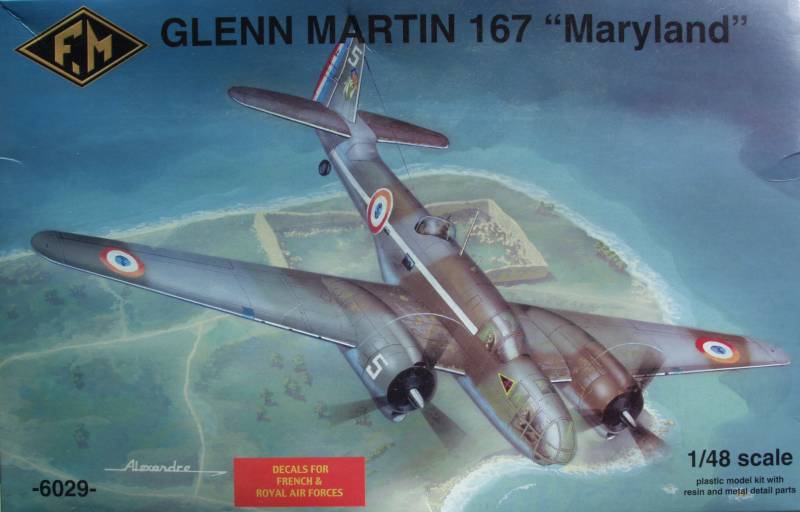
The Foundrie Miniatures kit comes is a two part top open box with a flimsy top and substantial bottom half. The top features nice artwork of the Maryland in flight. Inside the box one finds a large bag with all of the injected molded plastic parts and three small zip lock bags, two with cast metal parts and one with resin parts. The injection molded parts are gray in color and are typical low pressure molded parts. The parts feature recessed panel lines and these vary in quality and size. The fuselage and tail surfaces have typical sized panel lines that are uniform and consistent. The wings on the other hand have finer lines some of which just disappear and there are indications of lines that may have been in error and were filled but one can see a ghost of it anyway. For a low pressure molding the surface is actually pretty good but the fuselage and other areas could used a light sanding. All parts had a light amount of flash which is also typical for short run kits. The wings feature fixed ailerons but the kit also contains separate ailerons as if at some point a change was made in the design. You will read in the linked reviews that the panel lines are different on the two wings. I did not not see this but it may explain the corrected lines. The fabric covered areas consist of raise rib tapes which again varys depending on the parts. The ailerons seem to be better than the tail surfaces. The main outer surfaces of the airframe are for the most part free of blemishes. There is a notable lack of ejector pin marks and towers, just a couple inside the fuselage which will need to be removed. As is usual with kits of this type the mating surfaces tend to be rough and should be sanded on a flat surface before attempting assembly. The interior is made up of plastic, resin and metal parts, more on the last two later. The interior of the fuselage has no molded in detail and is pretty rough surface wise and will now doubt need to be sanded and thinned to get the interior to fit. The tires are weighted. All together there are 43 parts in gray of which the four aileron parts are not needed. Duplicate sprues are not shown. See below.
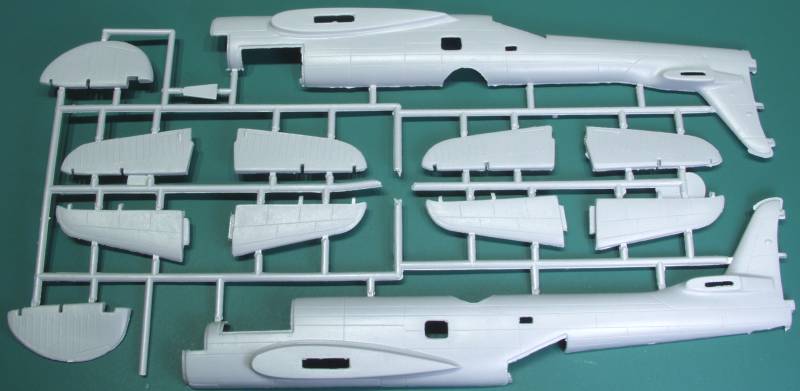
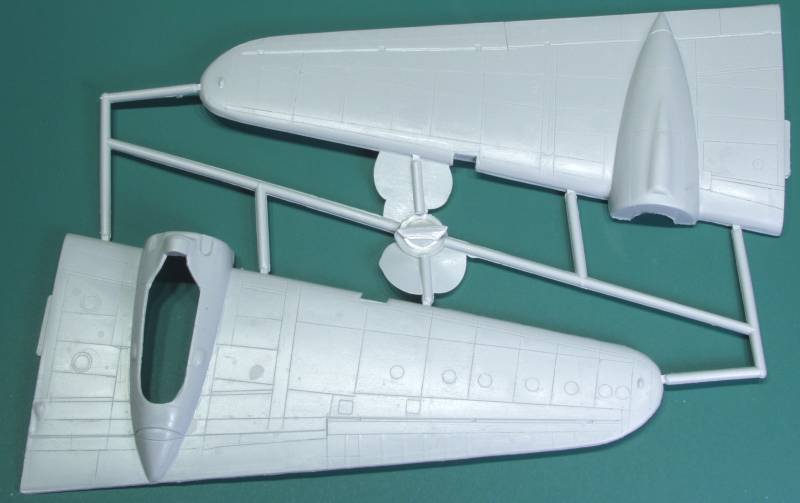
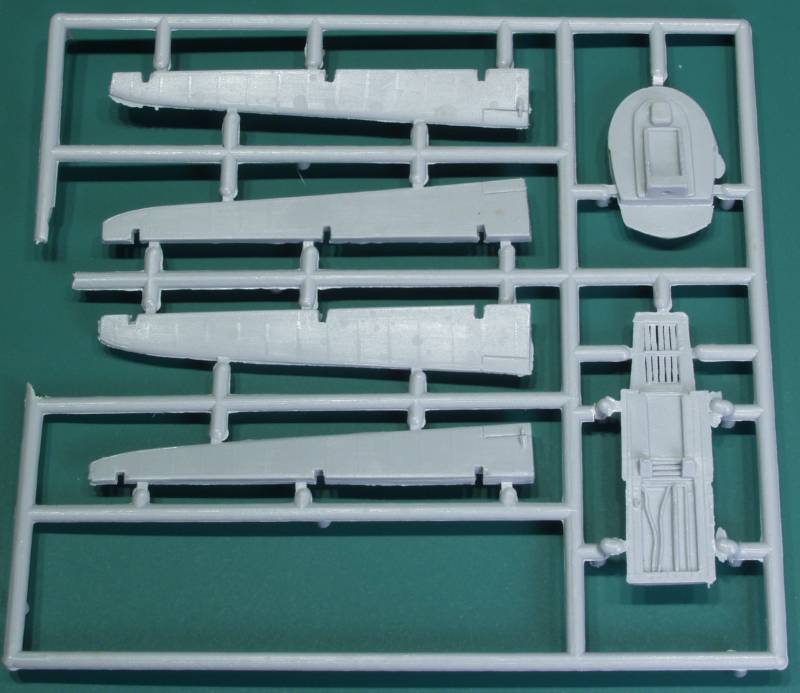
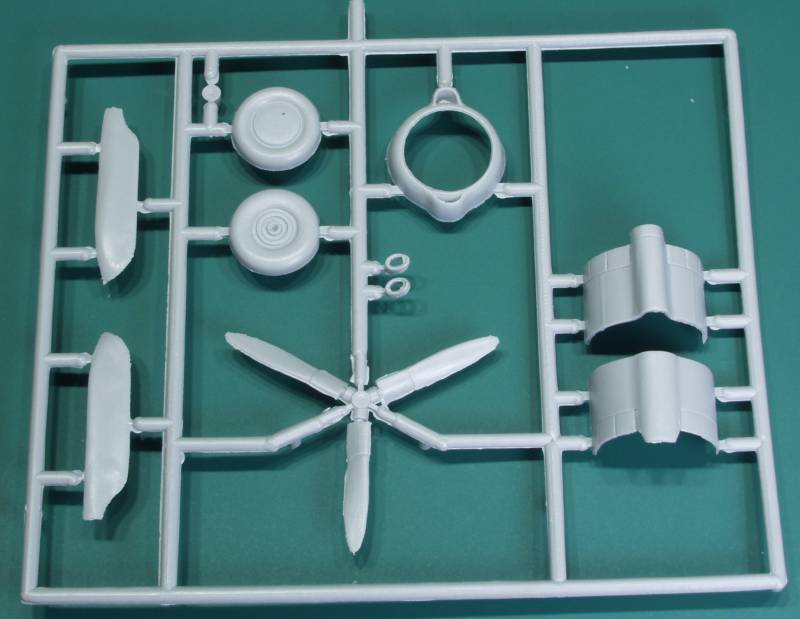
The resin parts are molded in a tan color and consist of the two landing gear bays, two seats less belts and harnesses and a bulkhead assembly. The wheel bays have a minimal amount of detail and feature a deep mounting socket for the main landing gear strut. The bulkhead is has a bit more detail but the seats are rather plain and have a rough surface texture. There was also a few pin holes t be found on the seats and bulkhead. See below.
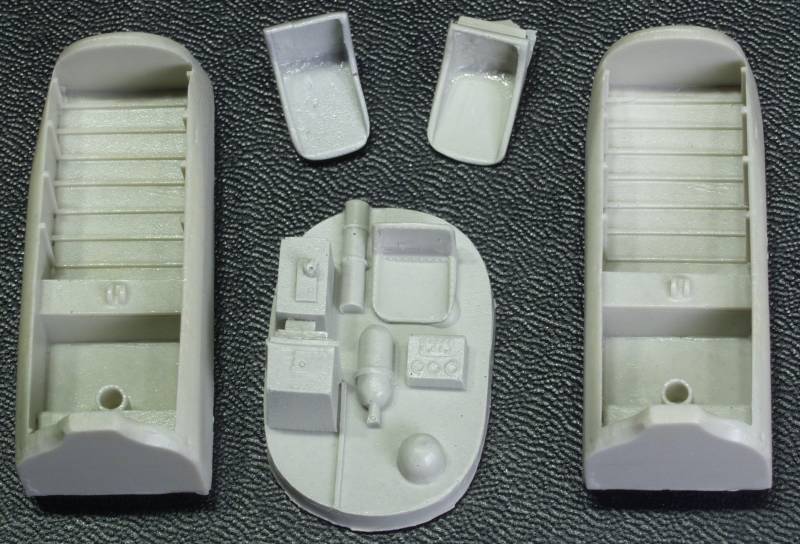
The first bag of metal parts contains the engines which has metal cylinders and resin crankcases. The cylinders have a light amount of flash but are reasonably well molded and should look OK when painted up. Two extras are supplied. The crankcases have a nice level of detail and I found no pin holes or short shots. See below.
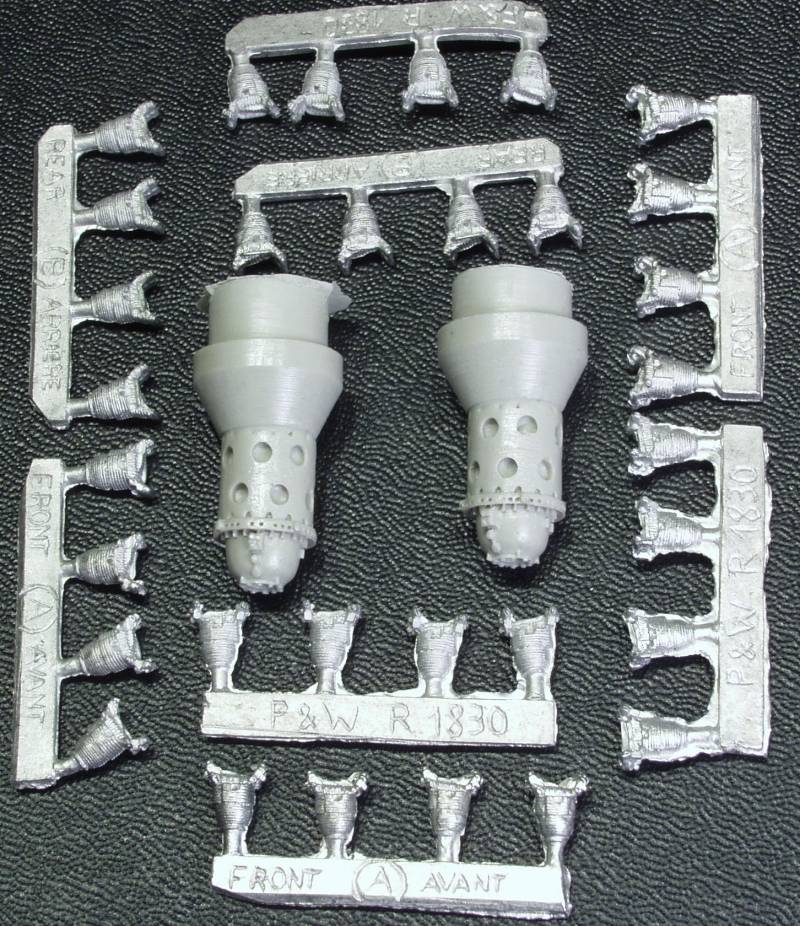
The second bag contains parts for the interior including side panels, instrument panel, turret base and gun mount, control columns, tail wheel, df loop, antenna mast, main landing gear struts, guns and a few miscellaneous interior bits and bobs as well as aileron hinges and engine cowling bumps. Some of the parts were molded better than others and some had more flash that will need to be cleaned up. The instrument panel will need some help in order to look decent. See below.
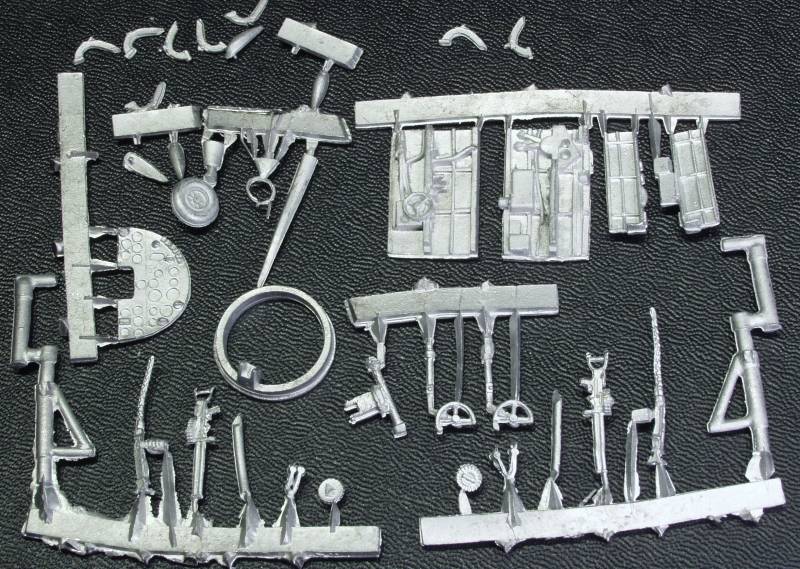
The clear parts are vacuformed, were not bagged but did not have any scratches that I could find. two sets were supplied but on one set the top of the turret was crushed and the clear areas were not as clear having a slight pebbly texture. The frame lines are well defined and they should look acceptable with a coat of Future.

The decals provide markings for two aircraft, one British and one French. They appear thin but they are not in register with the British markings being the worst. The unit marking for the French aircraft was apparently botched on the main sheet a replacement was provided on a second sheet. See below.
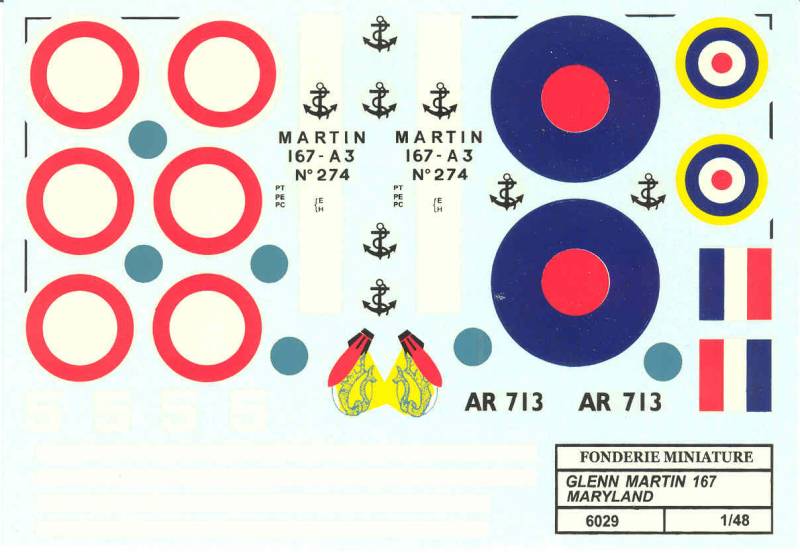
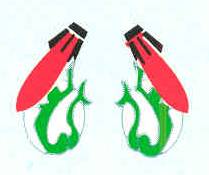
The instructions are printed on two A4 size sheets. One side of one sheet has the aircrafts history and specifications in two languages, two sides have assembly diagrams and one side has painting and marking information. While adequate they are hardly detailed and have no information on assembling the engines. For these a reference photo would be handy.
After Market Goodies
I know of none for this kit.
Conclusions
This is a typical FM kit, short run, low pressure molded, lots of clean up and dry fitting required, expect to do a lot of filling and sanding. With all that said I have seen FM kits that were much worse. There is a rumor that the kit was mastered from the Bill Koster's vacuformed kit. Whether true or not I have no way of knowing. The linked reviews below should give you an idea of what to expect should you decide to build one. In actuality the Koster vacuformed kit might be an easier build in the long run. Recommended to experienced modelers only.
Links to kit build or reviews
A build review can be found here and another inbox review here.
References
Not a lot available here, the history information above came directly from the Wikipedia.
Back to the Misc British page